For many aquarists, there’s nothing more exciting than setting up their first saltwater aquarium. While a freshwater aquarium can be beautiful, saltwater aquariums can host a wide array of striking aquatic life not found in freshwater tanks. Saltwater aquarium fish come in wide varieties, providing hobbyists with plenty of choices as to how they want to set up their tank.
With proper care, many exotic saltwater fish can thrive in an aquarium setting. Depending on your setup though, some fish will be better fitted for your personal aquarium than others.
Read our guide below where we explore some perfect fish species to keep in your home aquarium and some others you might want to avoid.
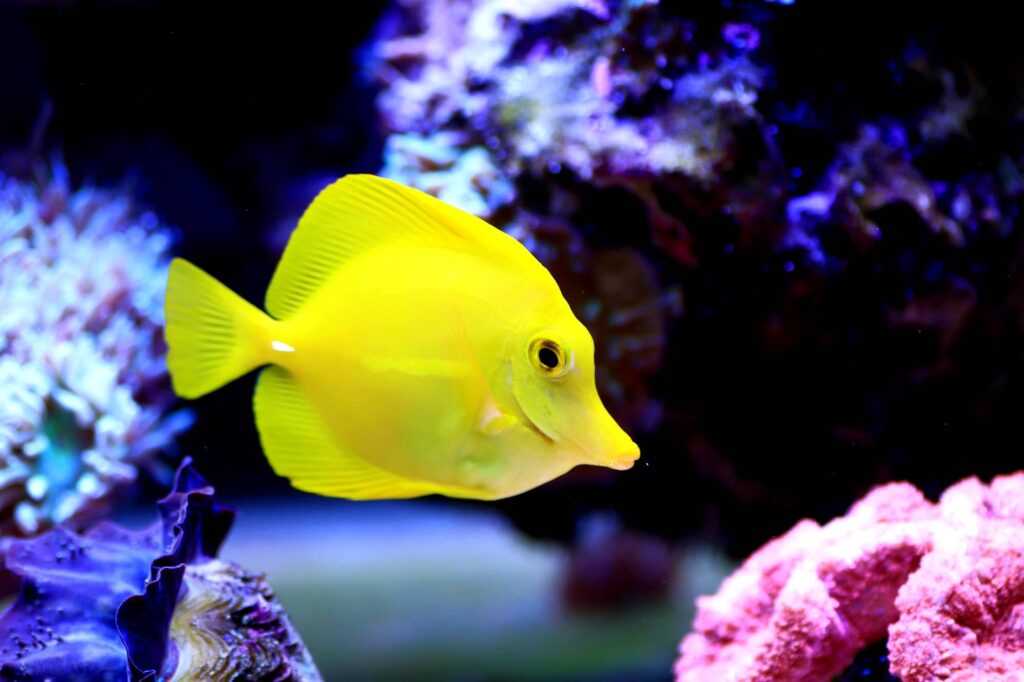
How to Choose Fish for Your Aquarium
It would be nice to keep any fish you liked in your home aquarium, but the sad truth is it simply isn’t possible. Certain aggressive fish don’t do well in a community aquarium, for example, and some larger fish will require plenty of space and additional resources. Even among peaceful tank mates, different fish have different dietary requirements needed to thrive.
In the freshwater hobby, many species of fish can happily be kept together — plenty of them are community fish that naturally occur together in the wild, making tank stocking pretty straightforward.
Saltwater aquarists, though, have to be more selective. While many species live together in the wild, marine life coexists differently on the reef compared to those in large freshwater rivers and lakes. The reef is alive with flora, fauna, predators, and prey. There is a strict balance between available resources and the biodiversity that it can support.
As a result, many reef fish have heightened aggression levels and special adaptations for sustaining their species, such as clownfish and wrasses that can change their sex as they mature.
In a saltwater tank, you’re taking just one piece of this vast ecosystem and transplanting it to your aquarium to build a community from scratch, and the only way to do that successfully is through careful planning. There are generally three setups hobbyists use for saltwater aquariums: fish-only (FO), fish-only with live rock (FOWLR), and full-reef.
Each of these has its own pros and cons, but your choice of setup will also determine the livestock you keep.
Fish-Only (FO) Setup
A fish-only setup is self-explanatory: an aquarium with only fish. In many ways, these aquariums are the same as freshwater setups and may be more familiar to beginner aquarists.
In essence, a fish-only setup only has the necessities for supporting fish: typically a filter, heater, powerhead, substrate, and artificial decorations. While it may not be as diverse, this setup is a popular choice for anyone looking to keep aggressive species.
Additionally, fish-only setups don’t have any stocking limitations. Generally, you only need to avoid pairing aggressive tank mates with shy fish and make sure your tank has a tight-fitting lid. Many saltwater fish are amazing escape artists!
For example, docile species such as cardinalfish or blue tangs will be content coexisting, as will equally aggressive species such as puffers and triggerfish. But you shouldn’t pair peaceful fish with dominant fish.
Fish-only setups are also great because you don’t have to worry about your fish eating any corals, though omnivorous species will likely need supplemental algae to thrive. We also recommend decorating the tank with plenty of rocks to mimic the natural cracks and crevices of coral reefs.
Fish-Only With Live Rock (FOWLR) Setup
FOWLR tanks are a nice middle-ground for hobbyists who want to keep a more natural ecosystem without having to bother with the high demands of a coral reef.
Simply put, these are fish-only setups with the addition of live rock that houses a plethora of beneficial bacteria and a variety of biodiverse micro-organisms.
Again, you can happily keep most species in this setup, keeping in mind their aggression levels.
Reef Setup
Many hobbyists dream of establishing a successful reef tank, but while they are stunning, they are also the most limiting of the three.
Generally speaking, species in the saltwater hobby will fall into one of two categories: reef-safe or not. Fortunately, because of their natural habitats, most species fall into the reef-safe category. The general exceptions are:
- Pufferfish
- Triggerfish
- Angelfish
- Butterflyfish
- Parrotfish
- Filefish
- Some wrasses
Of course, some niche species will also be incompatible in reef tank setups, but the list above includes the most common selection of fish among beginners.
And just as before, aggression levels will also determine which species you can keep.
The Best Saltwater Fish for Beginners
Once you’ve decided on the type of setup you’ll keep, it’s time to think about the fish that will inhabit it. Keep in mind that marine fish need significantly more space than freshwater species. Your top considerations when establishing a saltwater tank should be a larger tank size, the care level of each species, and support for a varied diet. That being said, here are our picks for some of the best saltwater fish for your aquarium for beginners and advanced hobbyists alike.
Beginner Saltwater Fish
Many people consider saltwater fish as being more difficult to keep than their freshwater counterparts, but there are plenty of hardy saltwater fish that tolerate less-than-optimal water conditions.
Damselfish
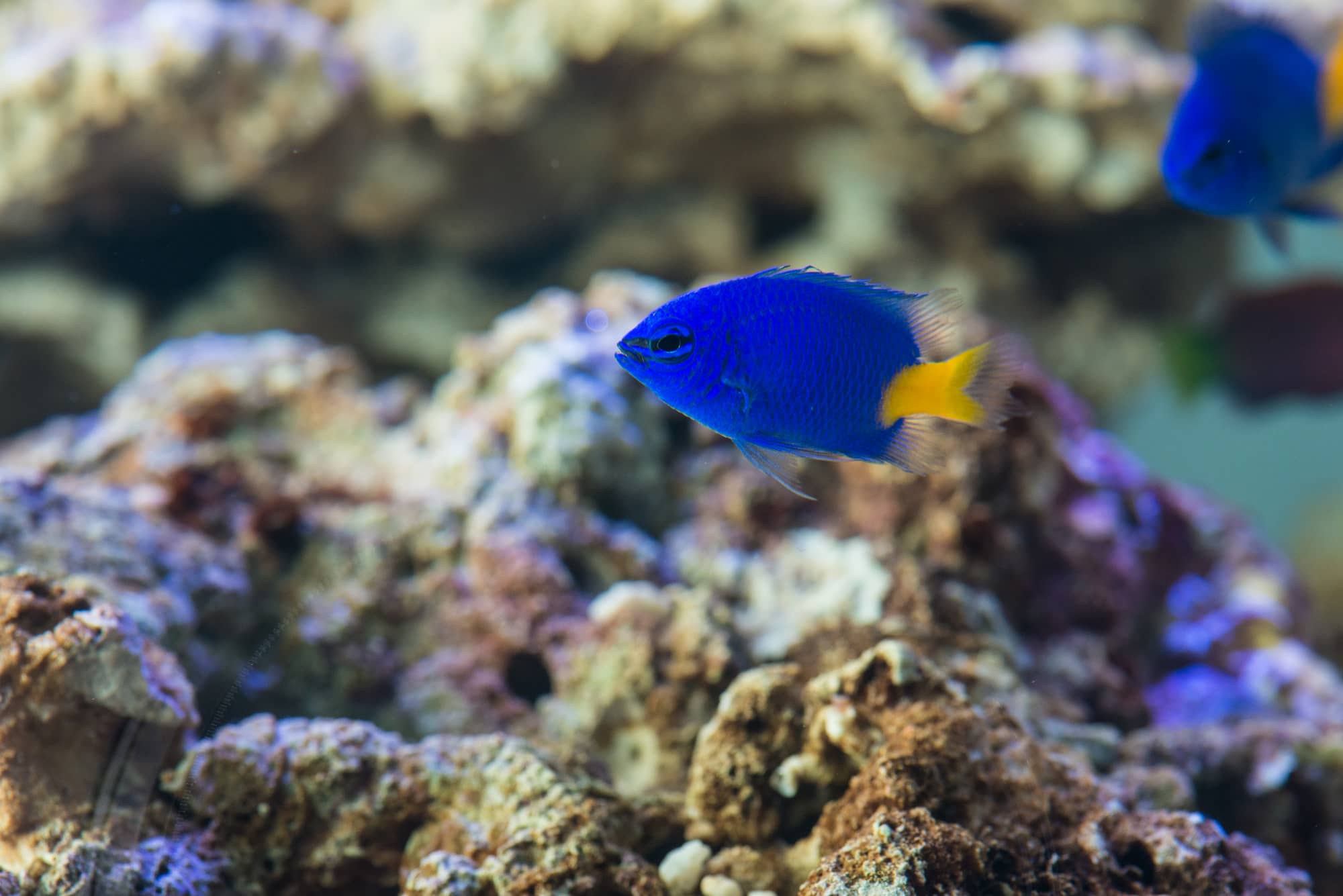
One of the most commonly recommended beginner fish due to their relatively inexpensive price, small size, and colors, damselfish comprise a number of popular saltwater species such as clownfish. Other common damselfish include:
- Three-Stripe Damselfish (Dascyllus aruanus)
- Fiji Blue Devil Damselfish (Chrysiptera taupou)
- Three-Spot Domino Damselfish (Dascyllus trimaculatus)
- Two-Stripe Damselfish (Dascyllus reticulatus)
Although these hardy fish can be kept in most aquarium setups, many beginner hobbyists don’t understand how aggressive they are.
Furthermore, they are territorial fish, so when they are introduced to the aquarium first, they consider it to be their territory, making it harder to acclimate other fish later on.
However, given the right setup and order of addition, these colorful fish can help to create a beautiful display. They need at least a 30-gallon tank (113.6 L) and are completely reef-safe, for the most part.
Clownfish, though, are generally less aggressive and a safe option to add at any stage of the aquarium. An individual or pair of clownfish can still show signs of aggression, but in groups, they acclimate well.
Two common clownfish species are the ocellaris clownfish (Amphiprion ocellaris) and the percula clownfish (Amphiprion percula), each of which only grows to be 3-4 inches and are much friendlier than some designer clownfish species.
Other non-aggressive damselfish include the blue damselfish, also known as the blue devil damselfish, and scientifically as Springeri damsel (Chrysiptera cf. springeri), and the azure damselfish (Chrysiptera hemicyanea
Firefish
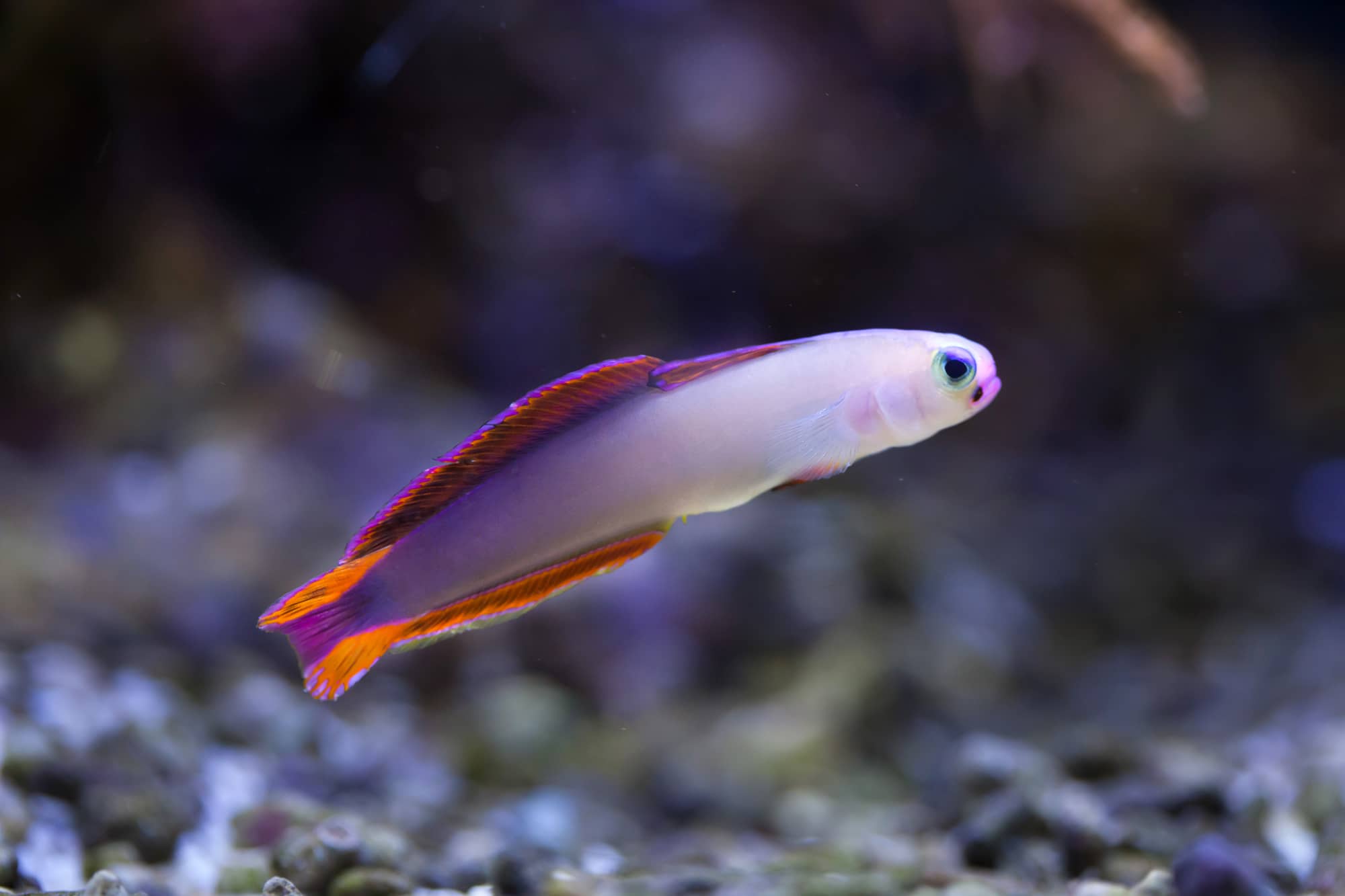
The firefish goby, often just called “firefish,” is another popular saltwater fish among beginner hobbyists. The two main varieties of firefish you’re likely to see are purple firefish (Nemateleotris decora) and regular firefish (Nemateleotris magnifica). And though they are beautiful, they are typically inexpensive fish — just another bonus!
Both varieties need the same basic requirements: Firefish do best in an, at least, 20-gallon tank (75.7 L), though some people report success in tanks as small as 10 gallons (37.9 L). They can be kept in mated pairs or as the only firefish in the aquarium.
Firefish are easy to keep happy and healthy, but the real challenge is getting them to stay in the tank. They are advantageous jumpers and will fit through the smallest of cracks, often finding their way into filtration plumbing.
Overall, though, they’re shy fish and may stay hidden in the rockwork or even bury themselves in the substrate for days at a time. They’ll want plenty of hiding spaces as they are prone to be bullied, and they pair well with less aggressive tank mates, such as other gobies, blennies, or cardinalfish.
Gobies
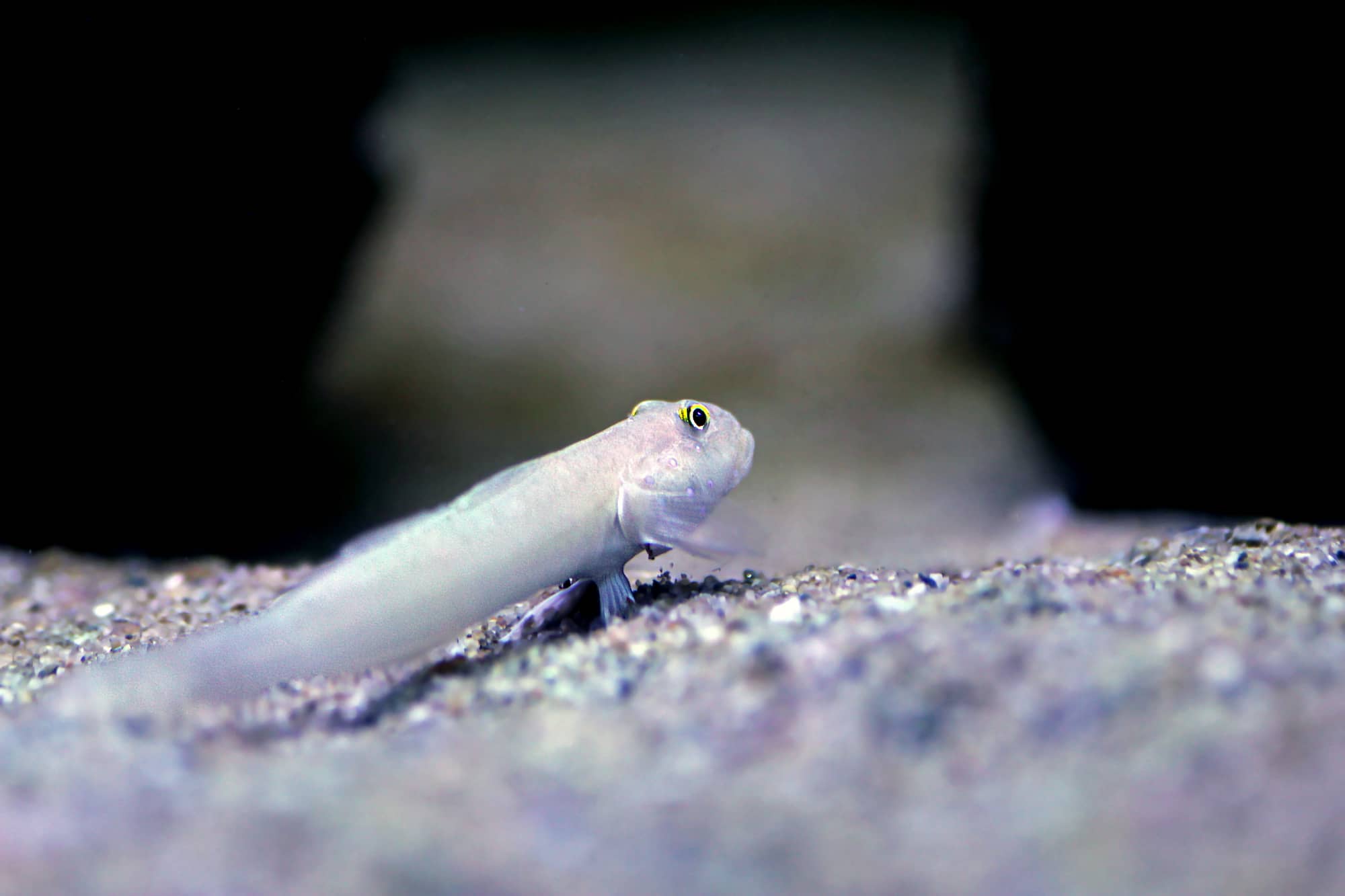
Gobies are curious, quirky little fish that bring color and excitement to the bottom of any aquarium, and many goby species have unique, interesting characteristics.
These fish do best with a soft substrate that allows them to construct tunnels under the rockwork. They are not territorial, though they will defend their tunnels from other gobies, blennies, and bottom-dwellers that might try to steal their home.
Some goby species are incredibly small and can easily make their home in a nano aquarium. In fact, some species can successfully be kept in a 5-gallon aquarium (18.9 L) with a symbiotic shrimp pairing.
Gobies form symbiotic relationships with shrimp, as seen with the yellow watchman goby (Cryptocentrus cinctus) and pistol shrimp (Alpheidae family) — the pistol shrimp helps build and maintain tunnels while the goby brings in food and offers protection.
Some of the most popular gobies include:
- Clown goby (Gobiodon citrinus)
- Neon blue goby (Elactinus oceanops)
- Sleeper gold head goby (Valenciennea strigata)
- Engineer goby (Pholidichthys leucotaenia)
- Diamond watchman goby (Valenciennea puellaris)
Blennies
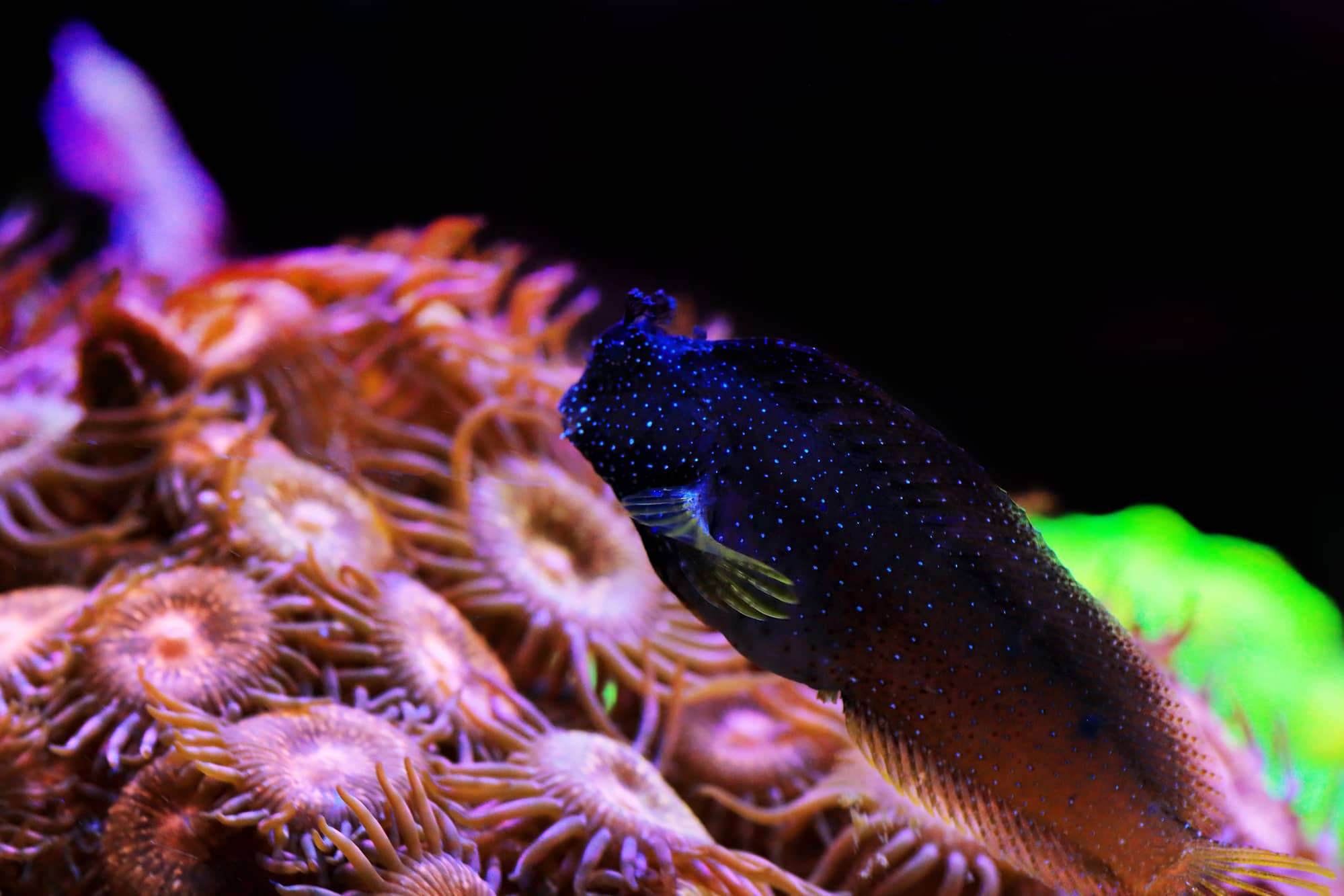
Blennies are similar to gobies but typically a bit larger. They have very bold personalities, and many hobbyists find blennies to be their favorite fish in the aquarium.
Like gobies, blennies do best with soft substrate where they can perch without getting scraped by coarse sand. Blennies especially like to pick at the rocks for algae and other micro-organisms, so they will thrive in better-established aquariums.
Though these fish are slightly larger than gobies, they can still successfully be kept in smaller aquariums with the right setup.
Here are some of the most common species of blenny to come across in the average home aquarium:
- Bicolor blenny (Ecsenius bicolor)
- Algae blenny (Salarias fasciatus)
- Canary blenny (Meiacanthus oualanensis)
- Starry blenny (Salarias ramosus)
Cardinalfish

Cardinalfish aren’t the most popular fish in the large polyp stony (LPS) coral or small polyp stony (SPS) coral-dominated system, but they are a favorite for soft reefs with macroalgae, especially due to their unique appearance.
There are only two species found in the aquarium hobby, both of which float in the water column: the pajama cardinalfish (Sphaeramia nematoptera) and the Banggai cardinalfish (Pterapogon kauderni).
Each typically requires at least 30 gallons (113.6 L), though, if they are the only fish in the system, hobbyists have managed to keep them in smaller setups.
Otherwise, cardinalfish don’t require any special care, and many aquarists have successfully bred them, also reporting the cardinalfish’s interesting parenting system as mouthbrooders.
Cardinalfish do best either alone or in pairs.
Wrasses
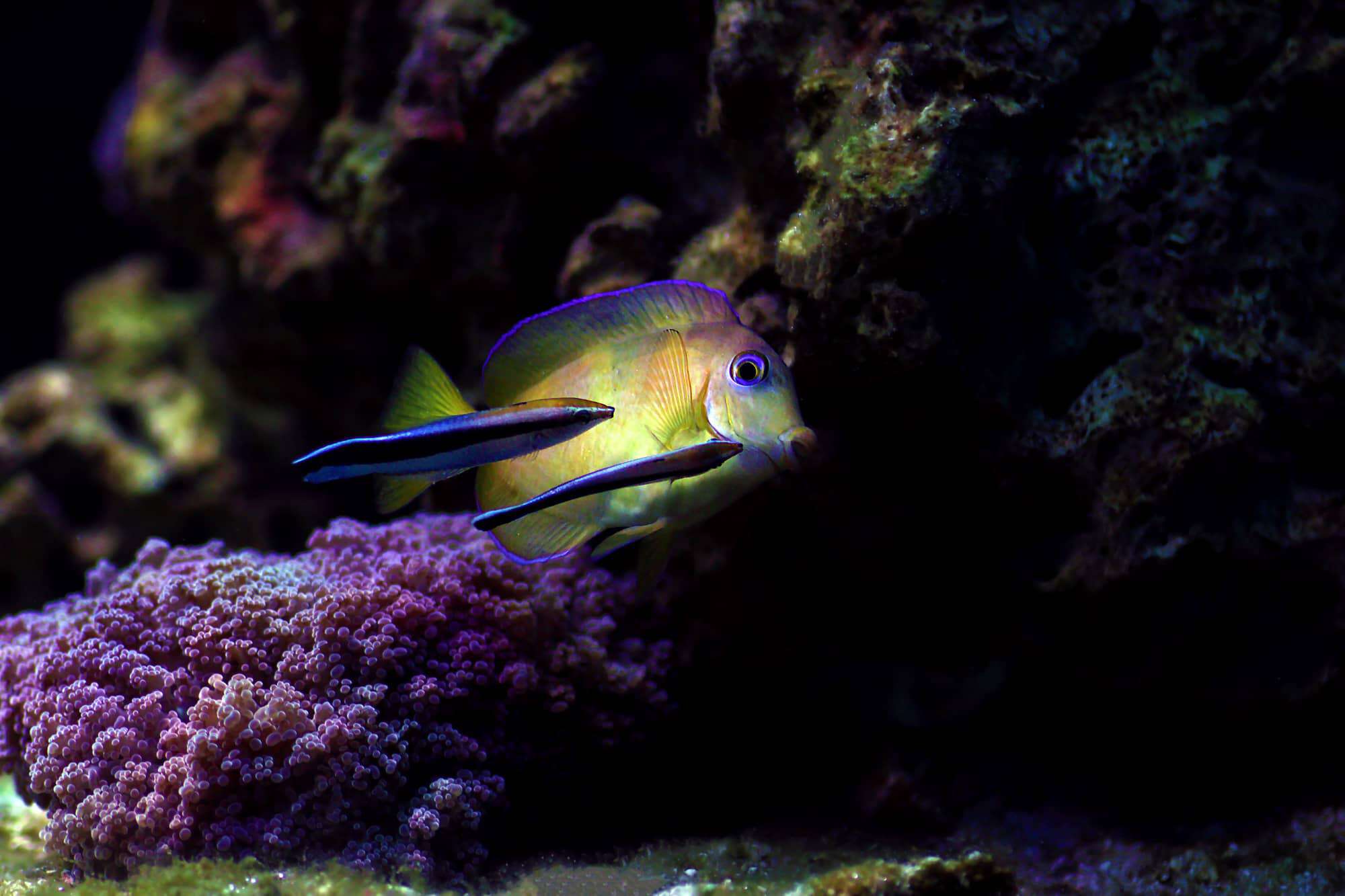
Wrasses are one of the most abundant and diverse types of saltwater fish in the home aquarium hobby, bringing a ton of movement and life to the aquarium. Many species of wrasse can also help with unwanted pests, like nudibranchs and even Aiptasia anemones.
Other species, such as the Bluestreak cleaner wrasse (Labroides dimidiatus), help pick parasites and foreign organisms off of other fish.
Because they’re so active, wrasses need larger aquariums. Some smaller species, such as the six-line wrasse (Pseudocheilinus hexataenia), still need 40 gallons (151.4 L), at the very least. They can do well in smaller tanks, too, as long as the tank’s length is greater than its height.
Wrasses have a tendency to jump out of the tank, so it’s important to put them in a tank with a tight-fitting lid. Interestingly, they also use the sand bed to sleep and retreat to when they’re frightened or startled.
This can become a problem if you’re dealing with a stressed wrasse as they may disappear in the sand bed and never come out, leading to water quality problems.
Otherwise, a tank full of wrasses can be one of the most colorful and active setups imaginable, as long as you maintain compatibility among species.
Of all the species available, these are the most common species of wrasse to come across:
- Yellow wrasse (Halichoeres chrysus)
- Bird wrasse (Gomphosus varius)
- Harlequin tusk (Choerodon fasciatus)
- Melanurus wrasse (Halichoeres melanurus)
- Red coris wrasse (Coris gaimard)
- Carpenter’s flasher wrasse (Paracheilinus carpenteri)
Though most species of wrasse are reef-safe, there are some genera that tend to be safer than others. We categorize wrasses generally as a beginner-friendly group, though some species can be much more demanding and costly.
Advanced Saltwater Fish
Those familiar with keeping saltwater setups may be looking to branch out into more elaborate, advanced setups, which also means keeping more exotic, albeit difficult, fish.
We’re defining difficult as being more sensitive to water parameters, having a particular diet, and/or needing substantially more space. Given enough time and care, though, fish in this category don’t prove to be much harder to keep than any other.
For the greatest chance of success, we recommend purchasing aqua-cultured specimen rather than wild-caught. Wild-caught fish tend to increase your chances of introducing disease and illness into the tank, and aqua-cultured species are generally hardier.
With that in mind, here are some of our favorite advanced saltwater fish:
Mandarin Goby
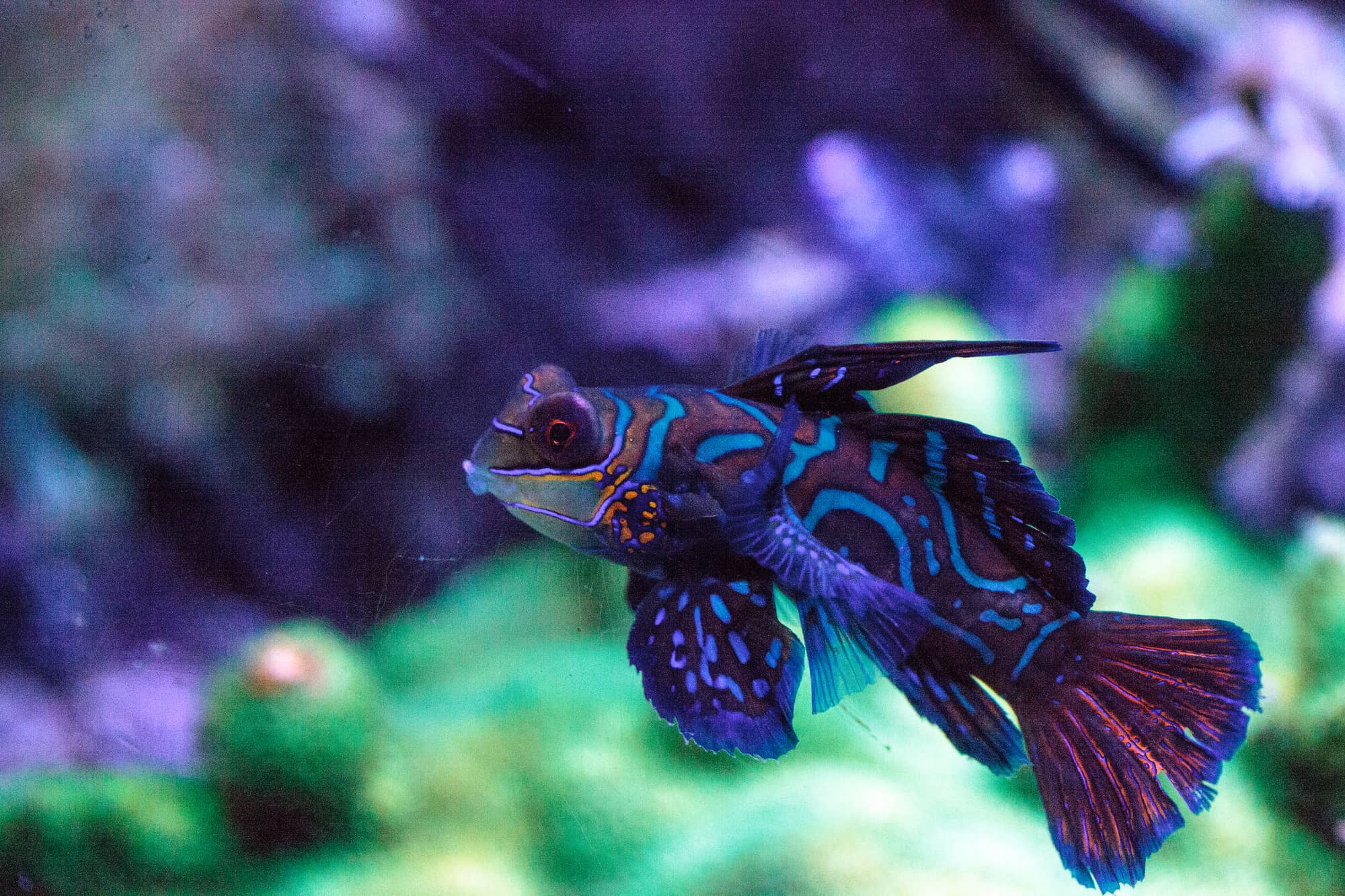
The mandarin goby (Synchiropus splendidus) is arguably one of the most beautiful fish available in the hobby, period. Their bodies are comprised of brilliant blues, greens, oranges, and yellows — colors that pop under aquarium lights! — and their inexpensive price makes them a favorite among hobbyists.
They only need a minimum tank size of 30 gallons (113.6 L), but it needs to be well-established with an abundance of natural flora and fauna. However, mandarin gobies have strict diets, and this makes them difficult to keep.
Their diet is comprised mainly of small insect-like animals found in and around the rockwork, such as copepods. They are also hesitant to eat frozen foods, though some people have found success in this regard.
Many mandarin goby owners set up copepod farms to provide their fish with a constant supply of food — even in a fully-stocked tank, mandarin gobies usually need supplemental nourishment.
Scooter Blenny

Scooter blennies (Synchiropus occelatus) are highly similar to mandarin gobies in terms of care, though they are slightly larger sized fish. Still, they generally do quite well in 30-gallon aquariums (113.6 L).
They too need a regular supply of copepods in the tank and additional supplemental feedings.
Tangs
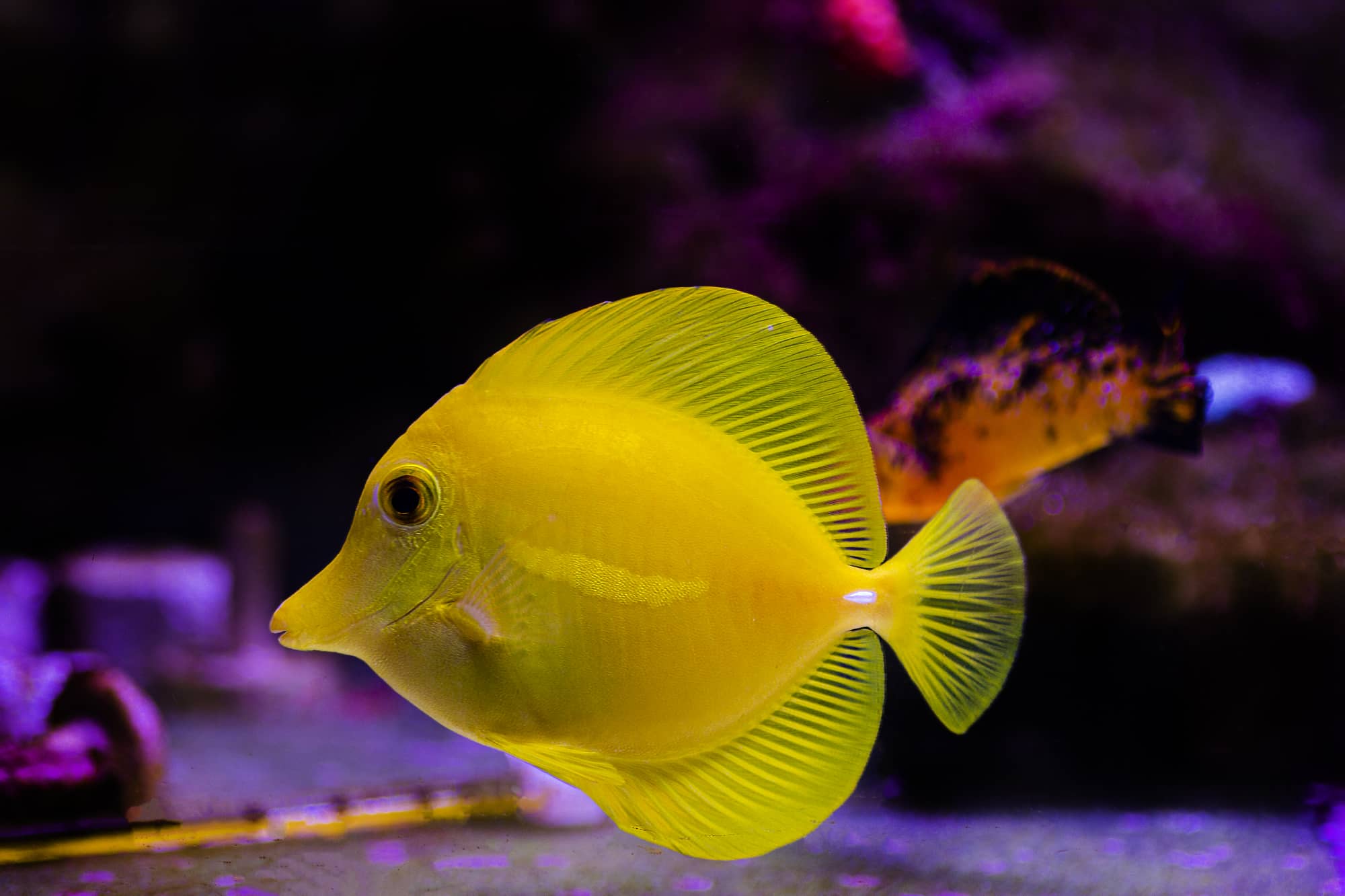
Tangs are a staple species for marine habitats. They are colorful, active fish, making them a popular choice among hobbyists.
Most tangs are actually quite easy to keep, such as the yellow tang (Zebrasoma flavescens), Kole tang (Ctenochaetus strigosus), and sailfin tang (Zebrasoma veliferum), but many beginner reefers don’t understand how large and active these fish actually are.
The minimum tank size for any tang is about 125 gallons (473.2 L). Of course, many hobbyists have successfully kept them in smaller aquariums, but too many people try keeping them in unreasonably small setups.
This is such a problem that online forum members are sometimes referred to as the ‘tang police’ when any of these species are kept in non-ideal settings.
Tangs also require a relatively mature setup — not quite as mature as one needed for gobies or scooter blennies — but enough for them to pick at algae growing on the rocks as they are constant grazers. If you don’t have a well-established tank, you’ll need to supplement their diet with various plant matter.
Angelfish
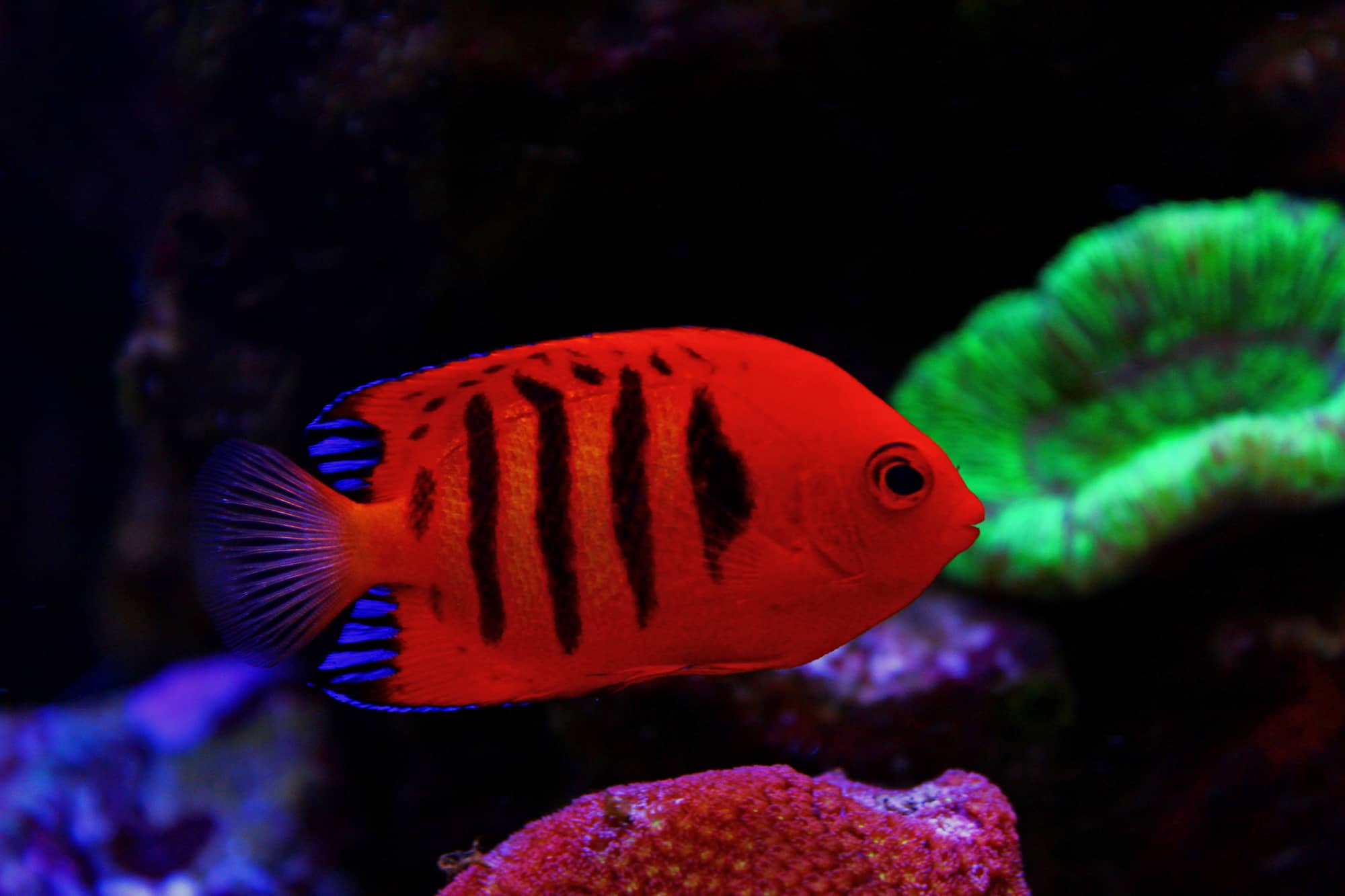
Some angelfish, such as the coral beauty (Centropyge bispinosa) and the flame angelfish (Centropyge loricula), initially seem perfect for a small, beginner saltwater aquarium. Don’t let their size fool you, though — angelfish require tanks of at least 55 gallons (208.2 L). Larger species, at full maturity, can require tanks of several hundred gallons as well.
They are constant grazers, notoriously known for eating corals, limiting them to either a well-established fish-only tank or a FOWLR setup. It’s not impossible to keep them in a reef setup — some hobbyists have done so successfully — but it depends entirely on the personality of the individual fish.
Butterflyfish

Similar to angelfish, butterflyfish need a ton of space and aren’t considered to be reef-safe. Many butterflyfish species need tanks of at least 75 gallons (283.9 L) in a fish-only or FOWLR setup.
However, some hobbyists introduce butterflyfish into their aquariums for pest control. Most notably, copperband butterflies (Chelmon rostratus) seem to be one of the most reef-tolerant species and reliably treat pest glass anemones such as Aiptasia.
Unfortunately, many people try to incorporate butterflyfish into tanks that are too small, and they die within a few months.
Chromis
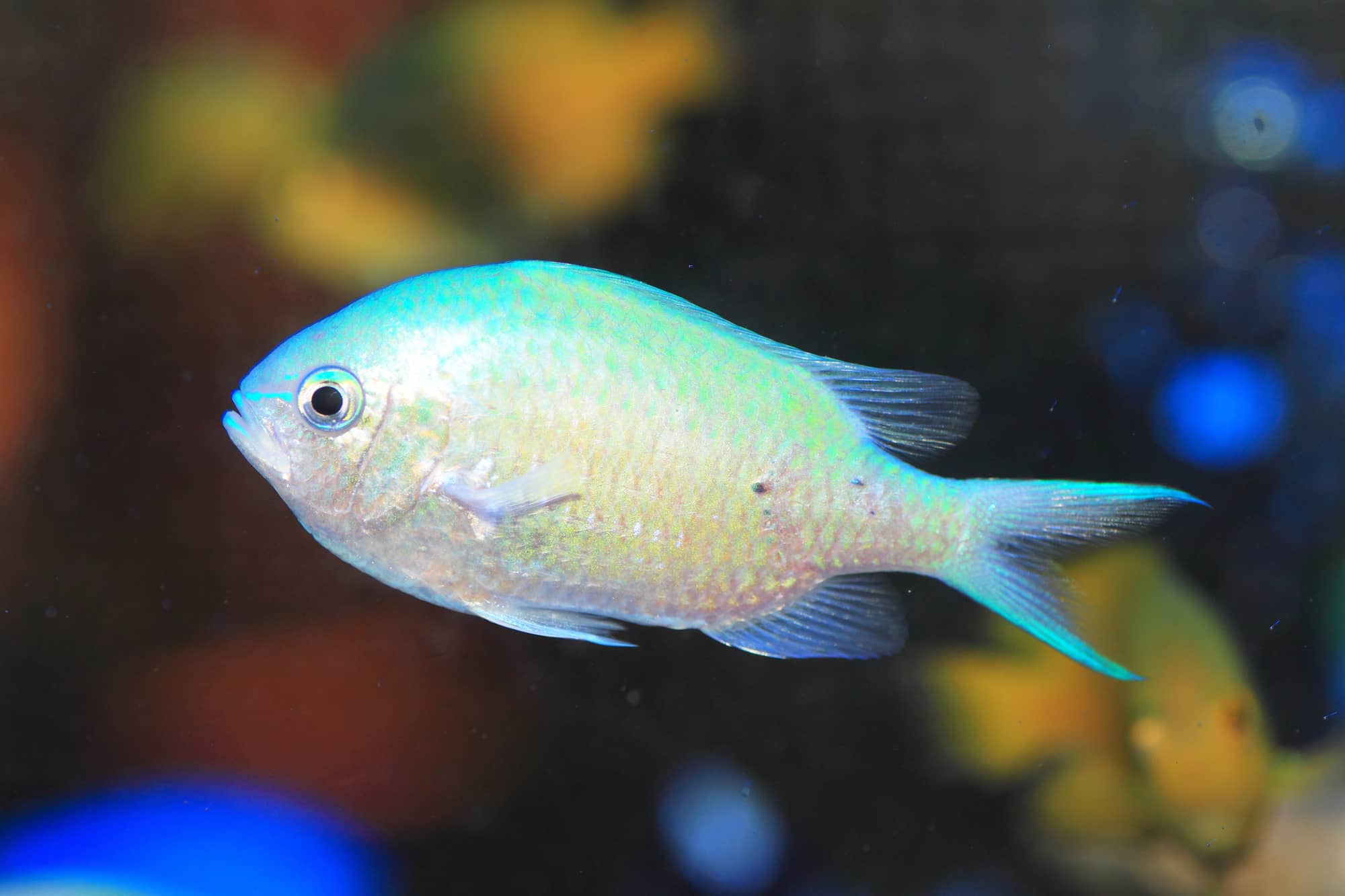
Many fish stores advertise chromis, such as the green chromis (Chromis viridis), as less aggressive than damselfish and just as easy to keep. This is a bit deceptive, though, since chromis are actually a species of damselfish.
Some beginner hobbyists are also under the impression they should keep a small school of chromis in their reef aquarium as their first fish, but this is a common misconception. Chromis aren’t active schooling fish in the aquarium. They develop an aggressive hierarchy, and the strongest pick off the weakest gradually until only one remains.
That remaining chromis also regularly becomes aggressive towards other species in the tank.
They certainly have their place in some reef setups, but most experts agree that you should avoid chromis in a newly-established system.
Conclusion
As the saying goes, there are plenty of fish in the sea. While some might not be ideal for your specific setup, there are certainly others that will be, and each can be beautiful in its own right.
If you’re new to the hobby, there are many beginner species that will help you create a unique saltwater aquarium with little strain. Plus, reefs are living, changing things — if, down the line, you want to expand into keeping more advanced species, the possibility is entirely present.
If you have any questions about the saltwater fish listed here, other rare marine species, or you’ve had experience stocking a tricky setup, leave a comment below!

